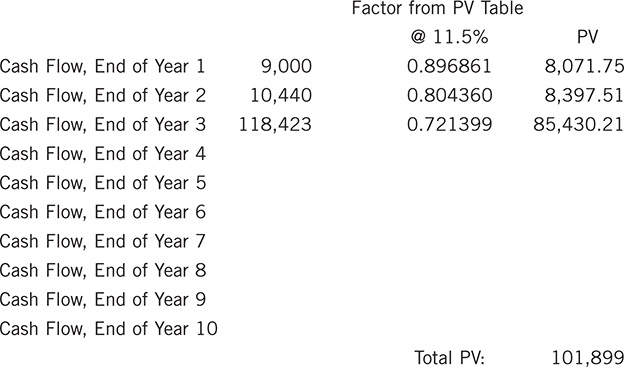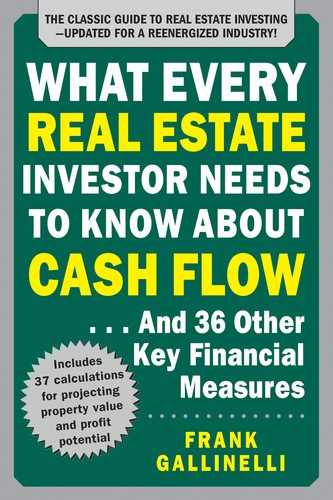CHAPTER 23
Calculation 17: Net Present Value
What It Means
If you followed our earlier discussions of present value and discounted cash flow, then you need to take only a small step to understand net present value (NPV). Recall that you performed a discounted cash flow analysis to find the present worth of all the property’s future cash flows at a given discount rate.
Let’s say that you require a 10.5% rate of return on your investment. When you discount all the expected future cash flows back at that rate, the PV that you find as your answer is the amount of cash you need to invest at 10.5% to achieve those future cash flows—with exactly the same timing and amount that you predicted.
The discounted cash flow analysis tells you what the future cash flows are worth at a given rate of return, but that isn’t necessarily how much you are going to pay for them. This is where NPV comes in. NPV is the difference between the PV of all future cash flows and the amount of cash you invest to purchase those cash flows. That’s why it’s called “net” present value.
If you invest exactly what the future cash flows are worth at a given discount rate (rate of return), then your investment is earning exactly that rate. If the PV of the cash flows is greater than the amount of your investment, you have a positive NPV, which is another way of saying that you’re really doing better than the specified rate of return because you’re getting more than you expected from your investment. If the PV of the cash flows is less than the amount of your investment, you have a negative NPV. That means that you’re not doing as well as the specified rate of return.
A term closely related to NPV is profitability index. Be sure to read the chapter on that topic after you complete this one.
How to Calculate
Again, you can use the Excel template we provide at http://www.realdata.com/book. Just fill in the initial investment, the cash flows, and the discount rate, and Excel calculates the PV of each cash flow and displays the NPV:

You can also use the form provided in Calculation 16, “Discounted Cash Flow,” to find the PV of all the future cash flows and then apply the following formula:
Net Present Value = Present Value of all Future Cash Flows
less Initial Cash Investment
We’ll use the form and the formula in the example that follows.
Example
You expect to purchase a property using a $75,000 cash investment, and you forecast that you will have the following cash flows:

You also estimate that the sale of your property five years from now will produce cash proceeds of $125,000. You believe your investment capital should achieve an 11.5% per annual return, so you choose to discount all future cash flows at that rate. What is the NPV of this income stream?
Use the discounted cash flow form to calculate the PV and then subtract your cash investment to compute the NPV. As you did in the chapter “Discounted Cash Flow,” fill in the cash flows and present value factors. Remember that the cash flow for year 5 is the sum of that year’s operating cash and sale proceeds.

Next, multiply each cash flow by its factor to find its PV and then total all the PVs. Round your total to the nearest dollar:

Now apply the formula:
Net Present Value = Present Value of all Future Cash Flows
less Initial Cash Investment
Net Present Value = 76,474 – 75,000
Net Present Value = 1,474
Test Your Understanding
You expect to purchase a property with $100,000 in cash and to operate it as follows:

Years 2 and 3
• Net operating income increases by 3% each year.
• Debt service remains constant.
• You plan no capital additions.
• You earn no interest on your bank account.
• You expect to sell the property at the end of three years for $475,000.
• You’ll spend 6% for costs of sale.
• At the end of three years, your mortgage balance will be $340,000.
• You believe your investment capital should achieve an 11.5% annual return.
What is the NPV of this investment?
Answer
First you need to calculate the cash flow for each year. Recall the formula:
Net Operating Income
less Debt Service
less Capital Additions
plus Loan Proceeds
plus Interest Earned
= Cash Flow Before Taxes
You have no capital additions, new loans, or interest earned, so your first-year cash flow is:
In years 2 and 3, your net operating income will increase 3%:
48,000 × 1.03 = 49,440 less 39,000 Debt Service = 10,440 Cash Flow (Year 2)
49,440 × 1.03 = 50,923 less 39,000 Debt Service = 11,923 Cash Flow (Year 3)
You will sell for $475,000 less 6% costs of sale and $340,000 mortgage balance:

Your total year 3 cash flow from operation and resale is 11,923 plus 106,500, or $118,423.
You now have enough information to use the discounted cash flow form:

One final step is necessary. You must find the difference between the PV of the future cash flows and your actual cash investment:
Net Present Value = Present Value of all Future Cash Flows
less Initial Cash Investment
Net Present Value = 101,899 – 100,000
Net Present Value = 1,899
Your NPV is slightly positive, which means that you expect to achieve slightly better than the 11.5% rate of return that you specified as your requirement.

